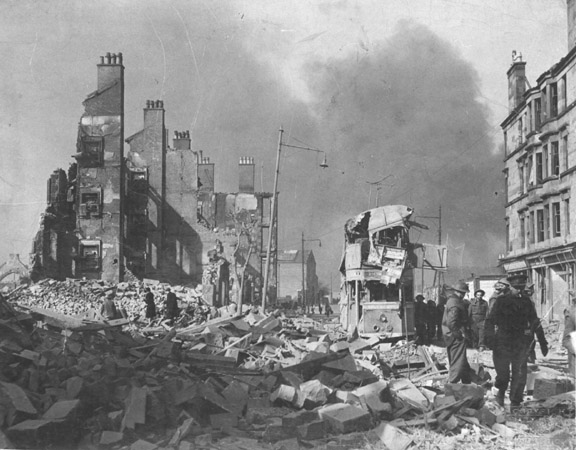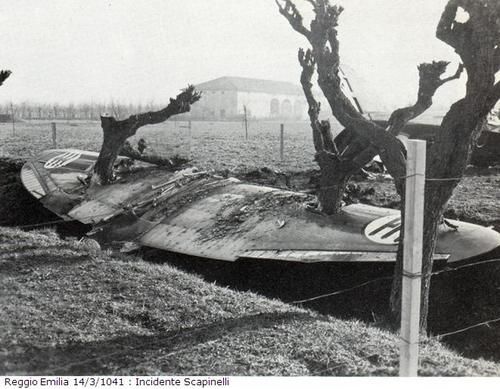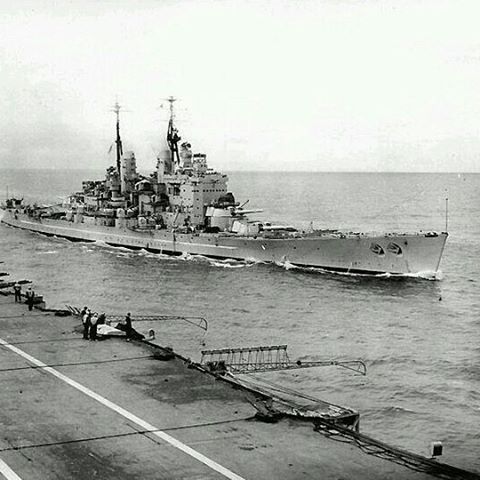Friday 14 March 1941
 |
| Damage to Clydebank from the Luftwaffe bombing of 13/14 March 1941. |
Mussolini, watching the activity from a mountain with a good view of Monastery Hill in the center of the line, is frustrated. However, things could be much worse for him than simply feeling bad about his troops' difficulties. Two Allied airplanes suddenly strafe the mountain that he is standing on. Everyone rushes to the shelter - and leave Mussolini behind to enter last. It is both a lucky escape and a commentary on the people surrounding him and their view of their leader.
Italian Chief of the Supreme Command General Ugo Cavallero has seen enough. He urges Mussolini to end the offensive and go over to the defensive. Mussolini, however, urgently wants to have some sort of Italian victory before the start of the German offensive from Bulgaria.
Air battles over the ground fighting are intense. The Italians are making a major effort to support the ground troops, and the RAF joins the party. The RAF claims eight Italian aircraft downed.
A handful of British Swordfish torpedo planes of RAF No. 815 Squadron based in Paramythia, Greece attack Valona (Vlorë), Albania. They sink an Italian hospital ship, the Po, and 3539-ton freighter Santa Maria at the cost of one aircraft (the Santa Maria is later raised and repaired). Needless to say, hospital ships are off-limits to attacks. Technically, this is a war crime. However, like many other such incidents throughout the war (on both sides), nothing comes of it. The British lose a plane, and the three airmen become POWs.
British Prime Minister Winston Churchill asks Foreign Secretary Anthony Eden to stay in Cairo until there is more clarity. Given that the British (and, unknown to the British, the Germans) are preparing radical departures in their activities in the region, this may be some time.
East African Campaign: Lieutenant-General William Platt has been stymied in front of Keren and its narrow entrance, the Dongolaas Gorge, for over a month. He has used that time to prepare his troops and wait for other British forces to put pressure on the entire Italian position in East Africa. Now, he is ready to attack on the 15th in a classic set-piece sequence of battles that focus on the Italian weak spots. He meets with his commanders on the 14th and warns them that it is going to be a bitter battle:
Do not let anybody think this is going to be a walkover. It is not. It is going to be a bloody battle: a bloody battle against both enemy and ground. It will be won by the side which lasts longest. I know you will last longer than they do. And I promise you I will last longer than my opposite number.This is a standard inspirational speech. However, for those who like to cast everything that Adolf Hitler ever did as eccentric and weird and revealing of his mental deterioration and so forth, compare its language to speeches Hitler makes around the time of the Ardennes Offensive in late 1944 and early 1945. He easily could have said those words. In fact, he actually did say some of them, such as the bit about lasting longer than his opposite number. This is simply how commanders under stress talk, whether they are winning or losing.
Some patrol actions take place around Mount Gegghiro. Two companies of the 4/16 Punjab climb 5000 feet up the mountain and displace some Italians who also are patrolling in the area. Punjab troops occupy the heights and install artillery, which can reach Engiahat.
The Luftwaffe, as is its tendency, returns to the same city that it creamed on the previous night. Having devastated Glasgow and the surrounding area on the night of the 13th, the Luftwaffe returns tonight. Just over 200 bombers attack Glasgow and Clydebank again, dropping 231 tons of high explosives. Further damage results to the shipyards and to the Rolls Royce engine factory there. This is known as the second night of the Clydebank Blitz.
It also is the night of the largest Luftwaffe attack of the war on Leeds. Tonight's raid begins at 21:00 when about 40 bombers attack the city and drop about 25 tons of bombs on it. The bombers aim for the city center, destroying about 100 houses and damaging 4600 others. In all, about 65 people are killed. Many historical buildings are destroyed or damaged, and you can see some bomb damage to this day in various structures. The antiaircraft defenders in the region down about five Junkers Ju 88 and Dornier Do-17 bombers, but it is unclear if they are involved in the Leeds raid, which is known as the Leeds Blitz.
The bombers also target surrounding towns, which likewise take a beating. This includes Huddersfield, near the site of a David Brown factory making Supermarine Spitfire parts, and Castleford. Sheffield receives special attention, with 117 bombers dropping 83 tons of high explosives and 328 incendiary bombs. This raid receives a blackout in the British media and is usually referenced as a "North East Inland Town."
RAF Bomber Command attacks oil installations at Gelsenkirchen with 101 bombers. Oil production in the city is interrupted temporarily. Also attacked by 24 bombers is Dusseldorf.
Battle of the Atlantic: Heavy cruiser Admiral Hipper has been at Brest, France for a month. It has had to be repaired after hitting some submerged objects in the harbor. It also needs a major refit which can only be done in Germany. In any event, Brest is becoming too "hot" for it to remain there indefinitely. The Germans ready it today for a return voyage to Germany via the Denmark Strait for a departure on the 15th.
German battleship Bismarck is preparing for its own sortie into the Atlantic. Tied up at Scheerhafen, Kiel, the warship is taking on supplies.
German S-boats have been active recently off the English coast. Today, they attack local Convoy FS 35, but destroyers HMS Vanessa and Holderness fight them off.
Italian submarine Emo torpedoes and sinks 5759-ton British freighter Western Chief in the Atlantic. Western Chief is a straggler from Convoy SC-24. There are 22 deaths.
The Luftwaffe bombs and sinks 1802-ton British freighter Stanleigh in the Mersey near the Bar Light Vessel. There are 17 deaths.
The Luftwaffe bombs and sinks 6507-ton British freighter Artemisia off Mundesley. There are two deaths.
The Luftwaffe bombs and sinks 94-ton British drifter Peaceful Star east of the Rockabill Lighthouse. Everyone survives.
The Luftwaffe bombs and sinks British drifter Peaceful Star in the Irish Sea southeast of Rockabill, County Dublin. Everyone survives.
The Luftwaffe attack on Liverpool damages several British ships: 179-ton tug Minegarth, 7006-ton freighter Scottish Chief, and 5691-ton freighter Empire Simba.
The Luftwaffe bombs and damages 4265-ton Norwegian freighter Tyr in the Humber near the Humber Light Vessel. The ship has to be towed to Immingham.
The Luftwaffe bombs Royal Navy minesweeper HMS Franklin in the North Sea. Four near misses damage it.
The RAF (Handley Page bomber) bombs and sinks 2365-ton Finnish freighter Wirma, recently renamed Rainer, off the German North Sea Coast. Its location is northeast of Norderney Island, between Cuxhaven and Emden. All 23 aboard survive, rescued by Swedish freighter Arete. Because of the ship's different names and other factors, this sinking tends to get cited separately as two (or more) sinkings. It had left Emden bound for Stockholm.
Brazilian freighter Santa Clara sinks in the Atlantic. It is believed to have been sunk by a submarine. Nobody survives.
Royal Navy 95-ton drifter HMS Jeannie Leasik hits a mine off Clacton-on-Sea. The captain beaches the ship at Brightlingsea Harbour. It ultimately is refloated and repaired.
British 2653-ton freighter Herport hits a mine and sinks off Cromer in the North Sea. There are four deaths.
Convoy HG 56 departs from Gibraltar.
Royal Navy submarine HMS Trusty and minesweeper HMAS Mildura are launched, and destroyer HMS Rocket is laid down.
US destroyer USS Monssen (DD 436, Lt. Commander Roland N. Smoot) is commissioned.
 |
| Brazilian freighter Santa Clara. A mystery ship, nobody survives its sinking on 14 March 1941. Perhaps sunk by a U-boat. |
The British are considering multiple courses of action in the Mediterranean basin - but none of them involve looking to the west. The obsession with the Wehrmacht forces in Bulgaria is at a fever pitch. The latest issue is whether or not to bomb infrastructure in Bulgaria. While a legitimate target due to the presence of German troops there, Bulgaria isn't at war with anyone. However, nobody is really too concerned about the rights of neutrals at this stage of the war.
On Malta, Lt. General William Dobbie, the island's governor and commander in chief, is knighted. He is now Lt. General Sir William Dobbie.
Convoy ANF 20 departs from Alexandria, Convoy AS 19 departs from Piraeus.
An Axis convoy of three freighters and three Italian destroyers departs from Tripoli bound for Naples. A five-transport convoy also departs from Naples bound for Tripoli.
Battle of the Indian Ocean: The Axis ships in East Africa have been fleeing for safety as British troops approach. It has been an infallible signal of Italian-held ports about to fall. Today, 9000-ton German freighter Coburg, which had been at anchor in the port of Massawa, is intercepted off the island of Mauritius. The crewmen scuttle the ship and are taken as prisoners.
German raider Komet, which has been meeting with fellow raider Pinguin in the Kerguelen Islands, departs today. Pinguin remains in the islands to receive supplies and to have its crew scrape barnacles from the hull and the like.
US/Japanese Relations: The new Japanese Consul General to Hawaii, Kita Nagao, arrives in Honolulu aboard the freighter Tatsuta Maru. He replaces Acting Consul General Ojiro Okuda, who has been spying on the US Fleet at Pearl Harbor.
Soviet Military: General Rodion Malinovsky becomes commander of Soviet 48th Rifle Corps.
China: The Battle of Shanggao (a county in the northwest of Jiangxi province) begins today when the Japanese 11th Army attacks the headquarters of the Chinese 19th Army.
Japanese Mitsubishi A6M "Zero" fighters have been dominant over China. Today, they score another major success. Chinese ace pilot (seven victories) Major Wong Sun-Sui is flying a Soviet-built I-15III fighter over the southern area of Chengdu, Sichuan Province when a Zero shoots him down. He makes it to a hospital in Sumatou District of Chengdu but perishes from a head wound.
That isn't all. In addition, ace pilot Cen Zeliu (five victories), also flying an I-15III fighter, is shot down apparently in the same engagement, also by a Zero. Cen is remembered as someone who did not pursue medals but was a fine combat pilot (and also deputy commanding officer of the 5th Pursuit Group). The Chinese have great difficulties in the air against the Japanese, and these victories cement the superiority of the Zero over the second-rate import fighters the Chinese use.
American Homefront: The Gallup Organization has been tracking public opinion about the war throughout the conflict. While polling techniques are primitive, the data does provide some information about feelings among ordinary Americans about the distant wars in places many couldn't even locate on a map. Today, in Public Opinion New Service, 14 March 1941, Gallup finds that a small majority of voters with an opinion feel that preventing the Japanese from occupying Singapore and the Dutch East Indies is worth a potential US war.
"Amapola (Pretty Little Poppy)" enters the Billboard singles chart. It will be a No. 1 hit for teen weeks.
Future History: Wolfgang Petersen is born in Emden, Germany. He studies theater, then works for West German television. After making his first theatrical film in 1974, Peterson makes a controversial film, "Die Konsequenz," then makes the film he is most remembered for, "Das Boot" (1982). It stars an old friend, Jürgen Prochnow, and tells the tale of a German U-boat. Having made his international reputation off "Das Boot," Peterson goes on to a major film career and still makes films occasionally.
March 1941
March 1, 1941: Rettungsboje
March 2, 1941: Oath of Kufra
March 3, 1941: Germans in Bulgaria
March 4, 1941: Lofoten Islands Raid
March 5, 1941: Cooperation With Japan
March 6, 1941: Battle of Atlantic
March 7, 1941: Prien Goes Under
March 8, 1941: Cafe de Paris
March 9, 1941: Italian Spring Offensive
March 10, 1941: Humanitarian Aid
March 11, 1941: Lend Lease Become Law
March 12, 1941: A New Magna Carta
March 13, 1941: Clydeside Wrecked
March 14, 1941: Leeds Blitz
March 15, 1941: Cruisers Strike!
March 16, 1941: Kretschmer Attacks
March 17, 1941: Happy Time Ends
March 18, 1941: Woolton Pie
March 19, 1941: London Hit Hard
March 20, 1941: Romeo and Juliet
March 21, 1941: Plymouth Blitz
March 22, 1941: Grand Coulee Dam
March 23, 1941: Malta Under Siege
March 24, 1941: Afrika Korps Strikes!
March 25, 1941: Yugoslavia Joins The Party
March 26, 1941: Barchini Esplosivi
March 27, 1941: Belgrade Coup
March 28, 1941: Cape Matapan Battle
March 29, 1941: Lindbergh Rants
March 30, 1941: Commissar Order
March 31, 1941: Cookie Bombs
2020



No comments:
Post a Comment